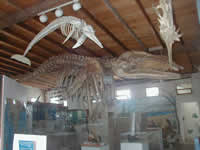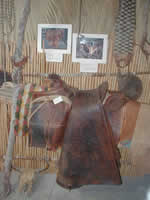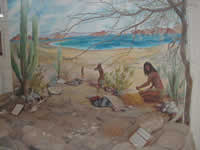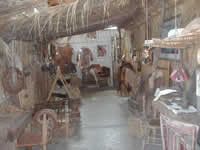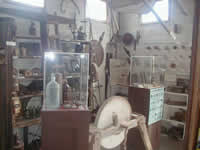HOME |
LOGBOOK |
| Volume
100 The very day we might have been expecting hurricane conditions from Ignacio, we woke in our anchorage off the pueblo of Bahia Los Angeles (BLA) to thick cloud cover and actual scattered showers. Reports had it that up to 20 inches of rain fell inland between La Paz and Escondido, washing out roads and bridges. Well, there was still enough moisture in the remnants that made it to BLA to give old T2 a good wash down (an incidentally, to flood the windows that Don has spent the last six months trying to get sealed!) The rain and cloud cover really cooled things off keeping the air temperatures in the cockpit down below 90 degrees, so we took advantage of the cooler temps ashore to do something we'd missed doing last year, and that was to visit the local museum. We had seen the sign last year, an unprepossessing hand-lettered thing on the edge of the grass-less and tree-less "zocalo," but had not been enough impressed with the village to imagine that their museum could have anything to offer us. Thanks to the Baja travelogue Miraculous Air by C.M. Mayo we were clued in to our misjudgment before we missed it. The first thing you see as you come up the lane is a bright orange mural on the outside wall, depicting the red and black cave painting murals that sprinkle the 600 or so remote mountain sites of northern Baja. We had hoped to go see some of these back in Mulege. In front of the mural is the reconstructed skeleton of a 54-foot finback whale. I had just finishing a book on back pain, and let me tell you, this guy had discs! The front yard of the museum is a miniature botanical garden, with plants--mostly of the cactus families--all carefully labeled and arranged between ore cars and one-man locomotives, rusty relics of the area's gold mining days. Inside we found some amazingly well-presented exhibits. The shell collection alone, presenting over 500 of the 600 some species of shellfish in the Sea of Cortez, is thoroughly organized and annotated by category in Spanish and English. Overhead was another whale skeleton, this one a gray whale, and there were displays of fossils and dried sea creatures and photographs of the once active turtle industry. Farther on was a collection of Cochimi Indian artifacts with a mural behind them depicting their primitive lifestyle. Next was a display of equipment from the rancho era, with saddles and lariats and thick leather chaps to prevent rider and horse from the nasty vegetation. Also a rough bunk and cooking utensils from the early days. Clearly none of these guys were tall! In the next corner was a collection representing the mining that was once done here, with rock samples and more equipment. Wending back towards the entrance were partitions hung with old photographs of the local families as well as some distinguished visitors, including Charles Lindbergh. The founder and director of the museum, Carolina Shepard, was not there when our group of cruisers passed through, but I had read C.M.Mayo's interview with her in Miraculous Air. Married to a Mexican, Ms Shepard had already lived in Bahia Los Angeles for twenty years before she undertook to coordinate the various piles of junk left lying around into something that could have meaning for the community. Many people--locals and visitors alike -- donated artifacts, time and talent to the collection. Although it should not be missed by any visitor to the Northern Sea, it has clearly been put together with an eye toward educating the upcoming generations of BLA residents to the interrelationships of man's activities and the natural environment around them. BLA residents still largely make their living from the sea, but bit by bit the emphasis is shifting from fishing to Eco-tourism. So far, the kind of tourism that has reached the Bay of the Angels, has been very low impact, mostly RVers and cruisers. Fonatur has not yet intruded with its heavy hand. Reprovisioned with fresh veggies, fruit and tortillas, the 2Cs moved north out of the Bay of Los Angeles to the Los Rocas Anchorage of Isla Coronado (also known as Isla Smith.) The Coronado refers to the flat-topped perfectly conical volcano of the island's northern end, which dominates the view of vessels approaching BLA. Last year we snuggled tight into Las Rocas with four or five other boats trying to hide from strong northwesterly winds. This year we were almost alone in flat calm conditions. We had expected to run across more of the boats that had gathered in Don Juan for Ignacio, so this was a pleasant surprise. Our enjoyment of the solitude was broken only by the blasts of passing whales, until one evening when the snarl of ATVs whined across the channel from Punta LA Gringa! With that we weighed anchor for Puerto Refugio, only to get tempted into Ensenada Alcatraz. Ensenada Alcatraz appears in only two of our three cruising guides, and in one of those it is tacked on at the end of a chapter, out of the sequence that you would encounter it, with the result that less cruisers seem stop there. Or it could be that they are discouraged by its reputation for honking elefantes (westerlies). On our way north, we had the long sweep of yellow sand and glittering water all to ourselves. We snorkeled its small island in great visibility and walked the beach following coyote tracks, while the wind generator cheerily pumped amps into our batteries. From Alcatraz it was only twenty-five miles more to Puerto Refugio. Puerto Refugio is one of the most beautiful anchorages in the whole of the Sea. The colors and shapes of Refugio's landforms are endlessly entrancing. On one hillside will be a forestof organ pipe cactus. On another slope are triangular piles of varying hues whose shapes defy familiar patterns of erosion. In a third direction are masses of red rock iced with guano. Actually, Refugio is not one anchorage, but four, and incredibly, we arrived to find them all deserted. We couldn't believe our luck. It is not so much that we don't like to share, than that we love the illusion of being in the remotest of spots. Last year we spent nearly two weeks moving among the anchorages with only one other boat who was out of sight most of the time. This year, the illusion lasted only a couple of days before a steady influx of cruisers began. When we left eight days later there were twelve boats at anchor, and a week after that there were sixteen! They are not having the same experience we did. Fortunately for us, when we first arrived, the snorkeling conditions were superb. The water was truly balmy and the visibility was up to 60 feet, very rare here in the Sea. We explored all over finding plentiful fish and scallops amidst fascinating rock formations everywhere we went. This year, there were no spear gun failures. The only problem the great white hunter had was that, since we only take what we can eat that day, he'd have his fish in the first five minutes! We even took Tackless out to Isla Granito for a photo pass of the sea lion colony there. Last year the pictures we shot from the dinghy got screwed up. For some reason I had hoped the basking animals would be less disturbed by the sailboat than the dinghy. NOT! I grabbed a few shots and we left them in peace. As the number of boats in Refugio increased, suddenly Don was busy again with watermaker calls. What happens is that one boat has a problem, everybody listens in on the radio discussions, and then suddenly they all start paying attention to systems they should have been paying better attention to all along. The Spectra watermaker is a wonderful device, which works reliably with amazingly little maintenance. But when that little attention slides over into no attention, deterioration in performance is inevitable. The good news is that Don was able to get everybody back up and running satisfactorily. It was yet another watermaker call that turned us back south. It was time anyway. The calendar told us we had just three weeks before we were due back in San Carlos (we'd gained a few weeks when Don's Dad's knee surgery was finally fixed for Oct. 9th), and the charm of Refugio was getting diluted by the crowd.
|
|
home
| waypoints | logbook | reference shelf
|



